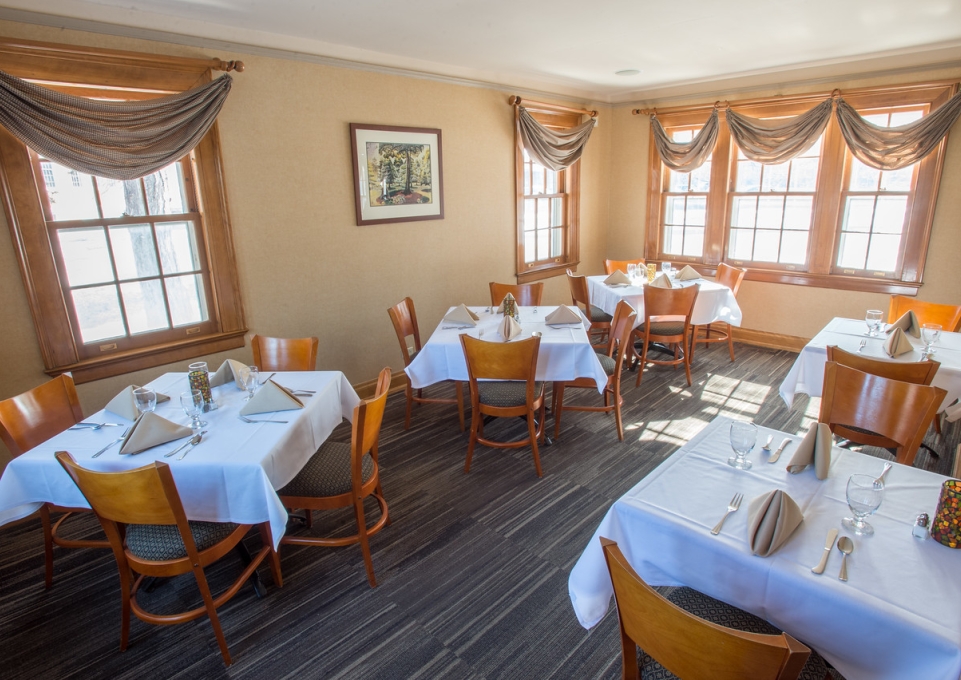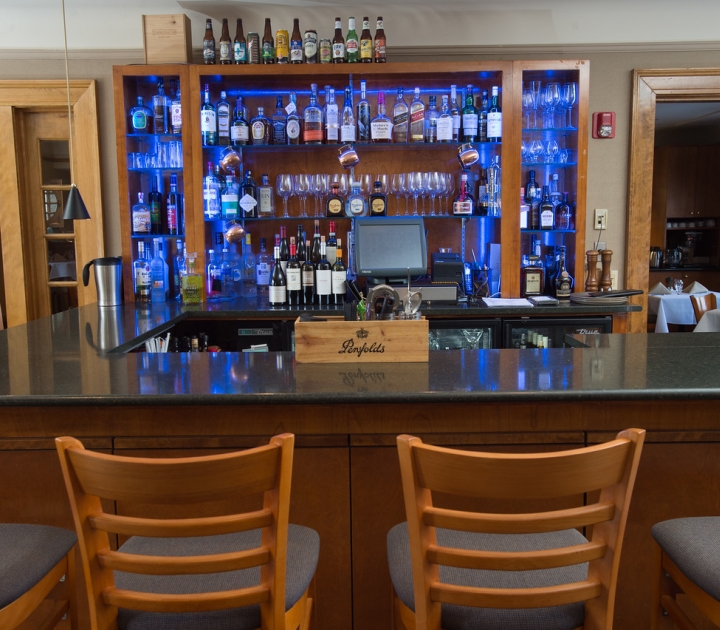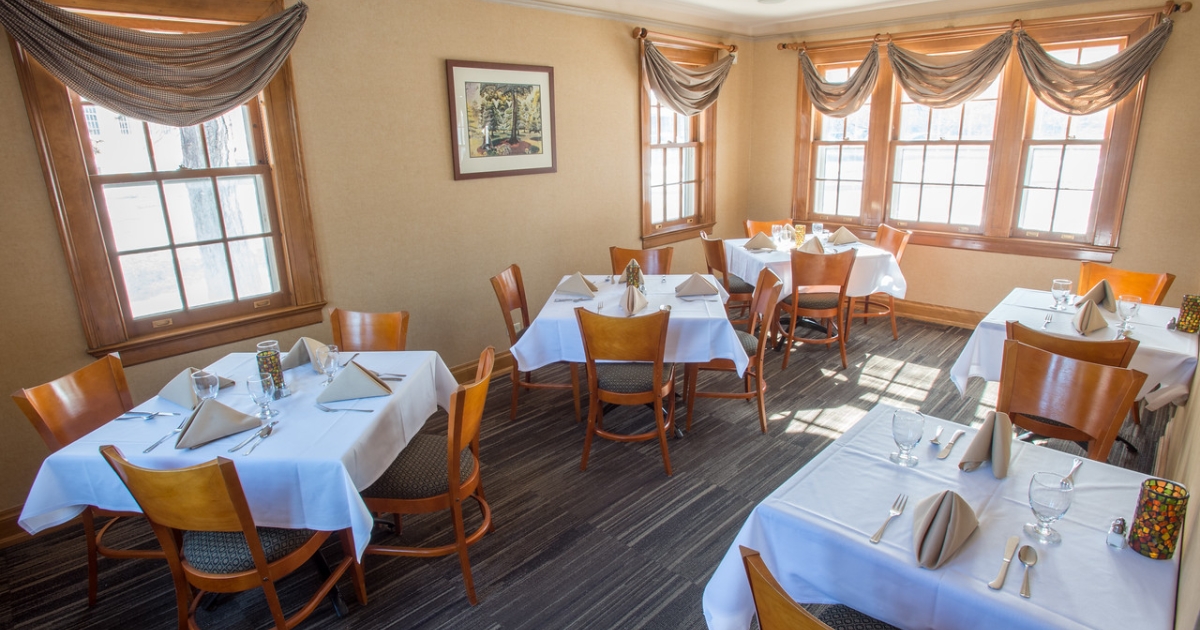
Created from a dream, a prayer, and dogged determination, Campus House opened as a teaching lab for the Hospitality and Tourism Department and a private dining club for the Buffalo State community 20 years ago. Since then, the gracious brick colonial revival structure tucked on the corner of campus has simultaneously echoed the college’s storied past and buzzed with students preparing for the future.
Typically, 40 students work at Campus House each semester, earning academic credit as they create original menus, manage and market the club, and conduct hospitality and tourism–related research.
One of Buffalo State’s five original buildings, Campus House initially served as the primary residence for three Buffalo State presidents and their families: Harry W. Rockwell, Harvey M. Rice, and Paul G. Bulger. In the late 1960s, the college used the building as a faculty lounge, then for administrative offices, and finally for dining services for the Faculty-Student Association—until a small group of faculty and staff members envisioned a space that could provide a training ground for hospitality administration students and connect disparate parts of the campus with elegant food in a friendly atmosphere.

One of Buffalo State’s five original buildings, the brick colonial revival structure initially served as the primary residence for three Buffalo State presidents and their families: Harry W. Rockwell, Harvey M. Rice, and Paul G. Bulger.
“Not only do students learn the intricacies of cooking, serving, and managing the front of the house; they’re also exposed to faculty members and administrators who get to know them,” said Kathleen O’Brien, lecturer and chair of the Hospitality and Tourism Department, who was instrumental in getting the popular dining club off the ground. “It provides another networking tool.”
Campus House has also evolved into a cozy spot for book clubs, artistic events, and more. The club offers members amenities such as complimentary coffee service from 8:30 to 11:00 a.m. Tuesday through Friday and an annual members-only picnic in the summer. It also boasts a full-service cash bar and a boardroom that seats 14, providing an ideal place for conferences, receptions, and retirement parties.
“Campus House is one place where everyone knows your name, not unlike the popular television show Cheers,” O’Brien said. “We wanted to have a private club with a bar for networking, and this was attractive to faculty, some of whom remember having a bar on campus back in the 1970s and ’80s.”
However, it almost didn’t happen.
“When we first started discussions, writing our business proposal and feasibility study, some naysayers on campus said we could never break the culture of faculty and staff eating lunch in their offices,” O’Brien said. “Also, the building was in disrepair and needed work.”
The boardroom provides an ideal place for conferences, receptions, and retirement parties.

In 1998, O’Brien was participating in a faculty internship sponsored by the Finance and Management Office. She was one of two faculty members who worked with then-Vice President of Finance and Management Stan Kardonsky.
“My project was figuring out how to upgrade the facilities for hospitality students, who were then using older kitchen equipment in Caudell Hall, while also creating something in which the whole campus could benefit,” she said.
Kardonsky put together a steering committee composed of representatives throughout campus, and they worked with his cabinet to create a business plan and bylaws.
Renovations began in 2000, and the newly imagined Campus House opened in fall 2002.
“Stan really believed in the project and said he wanted his membership card to read ‘No. 1 Member,’” O’Brien continued with a laugh. “I’m grateful we had his support and also that of highly respected faculty members and administrators, many of whom continue to visit regularly today.”
To generate excitement, the steering committee offered the campus a couple of promotions, including a sampling of foods that would be offered at the club before a performance at the Performing Arts Center.

Members enjoy such amenities as complimentary coffee service from 8:30 to 11:00 a.m. Tuesday through Friday and an annual members-only picnic in the summer, as well as a full-service cash bar.
“When Campus House opened, the reception was great,” O’Brien said, “and people were thoroughly excited. We found the perfect venue to teach specialty service training—cooking, food safety, how to run everything from lunch to special events. This is such an important skill set to give to our students.”
In spring 2002, O’Brien worked with faculty members who taught Principles of Food Service to have their students brainstorm menu ideas.
“This is where I found the start-up crew: Brendan Krebs, kitchen manager; Theresa Radder Keohane, guest services manager; and Josh Blumberg, general manager, all of whom are alumni of the hospitality and tourism program,” O’Brien said. “They joined me in the grand opening that fall. And it only grew and evolved from there.”
The first semester, Campus House had 50 members; by the end of the first year, there were 100.
Today, more than 300 faculty, staff, emeriti, alumni, and friends of the college are members. In 2019, Jeffrey Hirschfelt, ’07, ’12, took the reins as the club’s director.
“Each department across campus is represented among our members and guests,” Hirschfelt said. “It’s nice to see the camaraderie Campus House provides, with some groups meeting for lunch monthly. Others come more often.”
Hirschfelt noted that members of Campus House share the same core value: helping students.
“The regulars see students on their first day stumbling through the orders and then watch them grow over the next 15 weeks,” he said. “They get to know the students’ names, what their plans are, and sometimes help them find a job through their connections.”
“Not only do students learn the intricacies of cooking, serving, and managing the front of the house; they’re also exposed to faculty members and administrators who get to know them. It provides another networking tool.”
— Kathleen O’Brien, M.Ed., Campus House Founding Director; Chair, Hospitality and Tourism Department

Over the years, the dining club has offered special events, such as Beaujolais Nouveau, a worldwide celebration held on the third Thursday in November, marking the first release of a variety of wine made from the Gamay grapes grown in the Beaujolais region of France. Students wear tuxedos and white gloves while serving a seven-course meal with food and wine pairings.
“In the past, members have given our students a standing ovation and compliments for their work,” O’Brien said.
Laurence Shine, a longtime lecturer in the English Department, brought his James Joyce book club to Campus House for several years, and other faculty members have used the club to share their passions and talents: musical performances on the patio, cooking demonstrations in the kitchen, and an annual Artist’s Day. The latter, spearheaded by Carol Townsend, associate professor emerita of design, continues every April. Members choose an artist to highlight, and students create a meal and event based on the artist.
“One year, they chose Charles Burchfield,” Hirschfelt recalled, “and they made a dish of three different kinds of pasta arranged to mimic the swirl inside one of his paintings.”
This creativity based around food, fellowship, and graciousness would not be a reality if O’Brien and her cohorts had not persevered until the doors opened.
“How to take a project from concept to reality? Find the best people and be persistent with your vision,” O’Brien said. “Keep at it, and it will happen.”
Photos by Bruce Fox.



